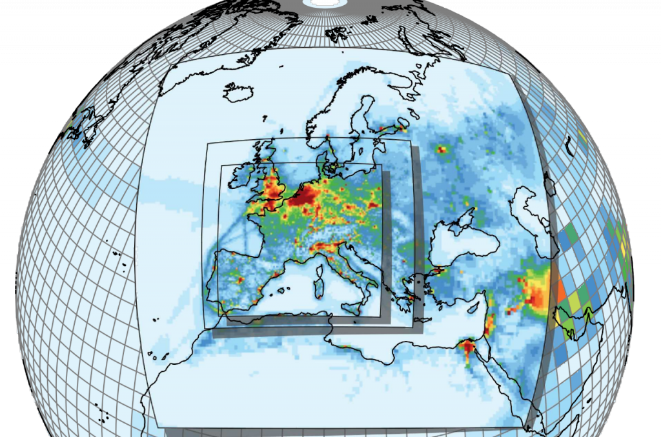CESM1 | COSMO | CLaMS | DWARF | ECHAM | ICON | MECO(n)
CESM1
The Community Earth System Model (CESM) is a fully coupled global climate model developed by NCAR (National Center for Atmospheric Research) in collaboration with colleagues in the research community. CESM provides state of the art computer simulations of Earth’s past, present, and future climate states. More information on CESM is available from the website https://www.cesm.ucar.edu/.
The implementation of CESM as a new base model into the MESSy framework is described in the publication of Baumgaertner et al., 2016.
COSMO
COSMO stands for COnsortium for Small-scale MOdelling. The general goal of COSMO is to develop, improve and maintain a non-hydrostatic limited-area atmospheric model, the COSMO-model, which is used both for operational and for research applications by the members of the consortium and other licensed institutes. Further details can be found at https://www.cosmo-model.org/.
Details on the connection of the numerical weather prediction model COSMO with the Modular Earth Submodel System (MESSy) to form a new, limited-area atmospheric chemistry model can be found in Kerkweg and Jöckel, 2012. The on-line nesting of the different model instances of ECHAM and COSMO by a client-server approach with the Multi-Model-Driver (MMD) is described in Kerkweg and Jöckel, 2012a. This on-line nesting is known as MECO(n) (MESSy-fied ECHAM and COSMO models nested n times).
CLaMS
CLaMS (Chemical Lagrangian Model of the Stratosphere), developed by Forschungszenrum Jülich IEK-7, utilises a unique transport and mixing scheme, which was optimized based on observations. The model is a world leader in simulating exchange processes in the atmosphere across transport barriers such as stratosphere-troposphere exchange. More details on CLaMS can befound on Institute of Energy and Climate Research website and in the publications of Plöger et al., 2015; 2015a.
The implementation of CLaMS into MESSy for application as base model or as submodel driven by EMAC is described in Hoppe et al., 2014.
DWARF
DWARF is a self-consistent MESSy base model to run arbitrary MESSy submodels. It consists of one main program file calling the CONTROL entry points in the correct order. DWARF can be used for simplified model applications, including one or more submodels, as the chemical box model (able to use the full MESSy diagnostics and output features), plume models, boundary layer models, etc. DWARF can also be used to work on performance optimisation (e.g., GPU ports, test parallel output,…).
ECHAM
ECHAM is an atmospheric general circulation model, developed at the Max Planck Institute for Meteorology. The ECHAM development branched from an early (ca 1987) version of the global numerical weather prediction model developed at the ECMWF, and has since been continually developed at the Max Planck Institute for Meteorology. A scientific documentation for ECHAM5 is provided in a special issue of the Journal of Climate, Vol. 19 (16), 2006.
The usage of ECHAM as base model to form the EMAC (ECHAM/MESSy Atmospheric Chemistry) model is published in Jöckel et al., 2005 and Jöckel et al., 2010. EMAC is also part of MECO(n) (MESSy-fied ECHAM and COSMO models nested n times).
ICON
The ICOsahedral Non-hydrostatic modelling framework (ICON) is a joint project between the German Weather Service (DWD, Deutscher Wetterdienst), the Max Planck Institute for Meteorology (MPI-M) for developing a unified next-generation global numerical weather prediction and climate modelling system. The ICON model has been introduced into DWD’s operational forecast system in January 2015. DWD and MPI-M pursue the ICON development together with their partner institutes. More information can be found at https://code.mpimet.mpg.de/projects/iconpublic and in Zängl et al., 2015.
The implementation of ICON as base model in MESSy is described in Kern and Jöckel, 2016.
MECO(n)
MECO(n) stands for MESSy-fied ECHAM and COSMO models nested n times. It features an on-line coupling of the global model EMAC with the regional model COSMO/MESSy. On-line coupling means, that the necessary boundary data for the regional model are exchanged during run-time between the EMAC and COSMO/MESSy instances, i.e. the global and regional model instances run in parallel. The exchange of the data is realized via single-sided, non-blocking MPI communication.
MECO(n) features an arbitrary number of different model instances. A global EMAC instance can drive various COSMO/MESSy instances at different geographical locations at the same time, and the COSMO/MESSy instances themselves can drive various finer resolved COSMO/MESSy instances in different regions, which themselves could drive further COSMO/MESSy nests.
More information on MECO(n) and an evaluation are provided by:
Kerkweg, A. and Jöckel, P.: The 1-way on-line coupled atmospheric chemistry model system MECO(n) – Part 1: Description of the limited-area atmospheric chemistry model COSMO/MESSy, Geosci. Model Dev., 5, 87–110, https://doi.org/10.5194/gmd-5-87-2012, 2012.
Hofmann, C., Kerkweg, A., Wernli, H., and Jöckel, P.: The 1-way on-line coupled atmospheric chemistry model system MECO(n) – Part 3: Meteorological evaluation of the on-line coupled system, Geosci. Model Dev., 5, 129–147, https://doi.org/10.5194/gmd-5-129-2012, 2012.
Mertens, M., Kerkweg, A., Jöckel, P., Tost, H., and Hofmann, C.: The 1-way on-line coupled model system MECO(n) – Part 4: Chemical evaluation (based on MESSy v2.52), Geosci. Model Dev., 9, 3545–3567, https://doi.org/10.5194/gmd-9-3545-2016, 2016.
Kerkweg, A., Hofmann, C., Jöckel, P., Mertens, M., and Pante, G.: The on-line coupled atmospheric chemistry model system MECO(n) – Part 5: Expanding the Multi-Model-Driver (MMD v2.0) for 2-way data exchange including data interpolation via GRID (v1.0), Geosci. Model Dev., 11, 1059–1076, https://doi.org/10.5194/gmd-11-1059-2018, 2018.

MECO(n) global-regional model system with refinements over Europe. Image: DLR, CC BY-NC-ND 3.0
